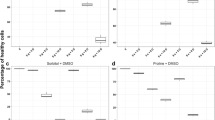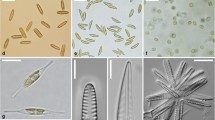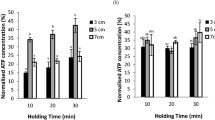Abstract
The viability of the marine microalgae Rhodomonas baltica Karsten, Isochrysis affinis galbana (Strain T-ISO) Parke, Chaetoceros gracilis Schütt, Tetraselmis chuii Butcher, Nannochloropsis gaditana Lubian and Nannochloris atomus Butcher, cryopreservec employing different cooling rates, either with or without the addition of the cryoprotective compounds dimethyl sulfoxide (DMSO) and methanol was studied at two exposure salinities. A viability index, which considered both cell recovery and the growth capacity of microalgae after thawing, was developed. The growth of thawed algae was compared to that obtained for unfrozen algae grown in liquid medium under the same conditions. Viability (V) was calculated according to the equation: V=(C 0/C i)x(C 7/(a·C b0 ))x100, where C 0 and C 7 are, respectively, the initial and final cell densities measured in the cultures after thawing from-196°C, C i is the maximum initial cell density (complete cell recovery), and a, b are the regression coefficients obtained for C 7 as a function of C 0 in the unfrozen controls. R. baltica was the only species that showed an improved viability when salinity was reduced from 36‰ (average viability 13.7% for 15% DMSO) to 20‰ (average viability 36.2% for 15% DMSO). The other five species displayed better viability only at the higher salinity at all tested cooling rates and cryoprotectant levels. T. chuii, Nannochloropsis gaditana, and Nannochloris atomus Butcher could be cryopreserved without cryoprotectant. However, their respective viabilities (32.7, 30.8 and 65.8%) at 36‰ S were progressively improved on addition of 5% DMSO (70.9, 48.2 and 93.5, respectively) and 15% DMSO (91.9, 57.0 and 94.2%, respectively). Similar improvements were found for Nannochloropsis gaditana and Nannochloris atomus when cryopreserved using methanol concentrations of 1% (average viabilities of 46.9 and 91.8, respectively) and 5% (average viablities of 48.7 and 95.3, respectively). Methanol was completely ineffective in cryopreserving the other four species and caused a lethal effect on T. chuii during freezing. C. gracilis could be cryopreserved with 5% DMSO only at 36‰ S. This resulted in a similar viability (11.7%) to that obtained using 15% DMSO in 20‰ S (13.7%). Keeping cryoprotectant concentration at 15% DMSO and raising salinity to 36‰ significantly improved the mean viability of C. gracilis to 21.6%. A low mean viability of 2.1% was obtained for I. galbana when 15% DMSO was used in full-strength seawater (36‰ S). Within the range of cooling rates tested (0.25 to 16 C° min-1), cryopreserved microalgae showed higher viabilities at faster rates in the absence of cryoprotectants at both salinities. Generally, the dependence on cooling rate decreased proportionally to the concentration of DMSO or methanol, as demonstrated by the lack of significance for the slope of the regressions. Only C. gracilis appeared to depend on faster cooling rates in the presence of 15% DMSO.
Similar content being viewed by others
References
Ben-Amotz A, Gilboa A (1980) Cryopreservation of marine unicellular algae. I. A survey of algae with regard to size, culture age, photosynthetic activity and chlorophyll-to-cell ratio. Mar Ecol Prog Ser 2: 157–161
Ben-Amotz A, Rosenthal H (1981) Cryopreservation of marine unicellular algae and early life stages of fish used in mariculture. Spec Publs eur Maricult Soc 6: 149–162
Cañavate JP, Lubian LM (1994) Tolerance of six marine microalgae to the cryoprotectants dimethyl sulfoxide and methanol. J Phycol 33: 559–565
Charlson RJ, Lovelock JE, Andreae MO, Warren SG (1987) Oceanic phytoplankton, atmospheric sulphur, cloud albedo and climate. Nature, Land 326: 655–661
Chevalier F (1991) Essais de cryoconservation d'algues unicellulaires d'intérèt aquacole. Institut National des Techniquesde la Mer de Cherbourgh, France
Crowe JH, Hoekstra FA, Crowe LM (1992) Anhydrobiosis. A Rev Physiol 54: 579–599
Day JG, Fenwick C (1993) Cryopreservation of members of the genus Tetraselmis used in aquaculture. Aquaculture, Amsterdam 118: 151–160
Dickson DMJ, Kirst GO (1987a) Osmotic adjustement in marine eukaryotic algae: the role of inorganic ions, quaternary ammonium, tertiary sulfonium and carbohydrate solutes: I. Diatoms and a rhodophyte. New Phytol 106: 645–655
Dickson DMJ, Kirst GO (1987b) Osmotic adjustement in marine eukaryotic algae: the role of inorganic ions, quaternary ammonium, tertiary sulfonium and carbohydrate solutes: II. Prasinophytes and haptophytes. New Phytol 106: 657–666
Fabregas J, Abalde J, Herrero C, Cabezas B, Veiga M (1984) Growth of the marine microalgae Tetraselmis suecica in batch cultures with different salinities and nutrient concentrations. Aquaculture, Amsterdam 42: 207–215
Fenwick C, Day JC (1992) Cryopreservation of Tetraselmis suecica cultured under different nutrient regimes. J appl Phycol 4: 105–109
Flassch JD, Salam G, Normat, Y (1975) Viability of a phytoflagellate after freezing. In: Avault JW (ed) Proceedings of the Sixth Annual Workshop of the World Mariculture Society, Louisiana State University. Seattle, Washington, pp 133–137
Grout BWW, Morris GJ (1987) Freezing and cellular organization. In: Grout BWW, Morris GJ (eds) The effects of low temperatures on biological systems. Edward Arnold, London, pp 147–173
Hempling HG (1987) Mass transfer of liquids across biological barriers. In: Pegg DE, Karow AM (eds) The biophysics of organ cryopreservation. Plenum Press, New York, pp 51–78
Kaplan D, Cohen Z, Abeliovich A (1986) Optimal growth conditions for Isochrysis galbana. BIOMASS 9: 37–48
Kirst GO (1989) Salinity tolerance of eukaryotic marine algae. A Rev Pl Physiol (Pl molec Biol) 40: 21–53
Kottmeier ST, Sullivan CW (1988) Sea ice microbial communities. 9. Effects of temperature and salinity on rates of metabolism and growth of autotrophs and heterotrophs. Polar Biol 8: 293–304
Laing I (1985) Growth response of Chaetoceros calcitrans (Bacillariophyceae) in batch culture to a range of initial silica concentrations. Mar Biol 85: 37–41
Laing I, Utting SD (1980) The influence of salinity on the production of two commercial important unicellular marine algae. Aquaculture, Amsterdam 21: 79–86
Lee RE (1989) Phycology. Cambridge University Press, New York
Liljenberg CS (1992) The effects of water defict stress on plant membrane lipids. Prog Lipid Res 31: 335–343
Lubian LM (1981) Crecimiento en cultivo de cuatro cepas de Nannochloris. Estudio de su citologia y composición de pigmentos como base para el establecimiento de su situación taxonomica. Ph.D. thesis. University of Seville, Seville, Spain
Lubian LM, Yufera M (1989) Colección de cepas de microalgas marinas del Instituto de Ciencias Marinas de Andalucia (CSIC). In: Yufera M (ed) Acuicultura Intermareal. Consejo Superior de Investigaciones Cientificas, Cadiz, Spain, pp 66–78
Mazur P (1964) Basic problems in cryobiology. In: Timmerhans KD (ed) Advances in cryogenic engineering. Vol 9. Plenium Press, New York, pp 28–37
Mazur P (1970) Cryobiology: the freezing of biological systems. Science, NY 168: 939–949
McLellan MR (1989) Cryopreservation of diatoms. Diatom Res 4: 301–318
McLellan MR, Cowling AJ, Turner M, Day JG (1991). Maintenance of algae and protozoa. In: Kirsop BE, Doyle A (eds) Maintenance of microorganisms and cultured cells (a manual of laboratory methods). Academic Press, pp 183–208
Meyer MA (1985) Cryopreservation of a marine diatom. Ph.D. thesis. University of Texas, A&M, College Station, Texas
Morris GJ (1976) The cryopreservation of Chlorella. 1. Interactions of rate of cooling, protective additive and warming rate. Archs Microbiol 107: 57–62
Morris GJ (1978) Cryopreservation of 250 strains of Chlorococcales by the method of two-step cooling. Br Phycol J 13: 15–24
Morris GJ (1981) Cryopreservation. Institute of Terrestrial Ecology, Cambridge, England
Morris GJ, Coulson G, Clarke A (1979) The cryoprotection of Chlamydomonas. Cryobiol 16: 404–410
Pitt RE (1990) Cryobiological implications of different methods of calculating the chemical potential of water in partially frozen suspending media. Cryo-Letters (Cambridge, UK) 11: 227–240
Rabinowitch S, Grover NB, Ginzburg BZ (1975) Cation effects on volume and water permeability in halophilic alga Dunaliella parva. J Membrane Biol 22: 211–230
Rall WF, Reid DS, Farrant J (1980) Innocuous biological freezing during warming. Nature, Lond 286: 511–514
Saks NM (1978) The preservation of salt marsh algae by controlled liquid nitrogen freezing. Cryobiol 15: 563–568
Steponkus PL (1984) Role of the plasma membrane in freezing injury and cold acclimation. A Rev Pl Physiol 35: 543–584
Steponkus PL, Langis R, Fujikawa S (1992) Cryopreservation of plant tissues by vitrification. In: Steponkus PL (ed) Advances in low temperature biology. Vol 1. JAI Press, London, pp 1–61
Taylor MJ (1987) Physico-chemical principles in low temperature biology. In: Grout BWW, Morris GJ (eds) The effect of low temperature on biological systems. Edward Arnold, London, pp 3–71
Thompson AS, Rhodes JC, Pettman I (1988) Culture collection of algae and protozoa catalogue of strains. CCAP (Culture Collection of Algae and Protozoa). Windermere, England
Vargo GA, Fanning K, Heil C, Bell L (1986) Growth rates and salinity response of an antartic ice microflora community. Polar Biol 5: 241–247
Author information
Authors and Affiliations
Additional information
Communicated by A. Rodríguez, Puerto Real
Rights and permissions
About this article
Cite this article
Cañavate, J.P., Lubian, L.M. Relationship between cooling rates, cryoprotectant concentrations and salinities in the cryopreservation of marine microalgae. Marine Biology 124, 325–334 (1995). https://doi.org/10.1007/BF00347136
Received:
Accepted:
Issue Date:
DOI: https://doi.org/10.1007/BF00347136




